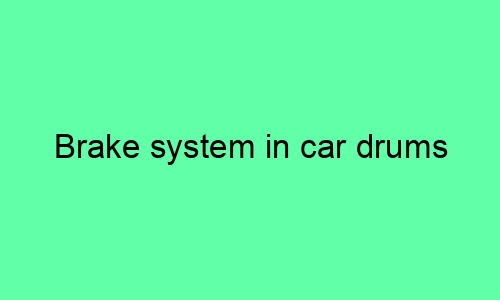Brake System in Car Drums
Introduction
The brake system in a car is responsible for slowing down or stopping the vehicle. It consists of several components, including the brake pedal, master cylinder, brake lines, calipers, and brake pads. The brake system works by converting the kinetic energy of the car into heat, which is then dissipated through the brake pads and rotors.
Types of Brake Systems
There are two main types of brake systems in cars: drum brakes and disc brakes. Drum brakes are the older type of brake system, and they are still used on some vehicles today. Disc brakes are more modern and efficient than drum brakes, and they are becoming increasingly common on new vehicles.
Drum Brakes
Drum brakes work by pressing a pair of brake shoes against the inside of a rotating drum. The brake shoes are lined with friction material, which creates friction and slows down the drum. Drum brakes are relatively inexpensive to produce, but they are not as effective as disc brakes. They are also more likely to fade, which means that they can lose their effectiveness after repeated use.
Disc Brakes
Disc brakes work by pressing a pair of brake pads against a rotating disc. The brake pads are lined with friction material, which creates friction and slows down the disc. Disc brakes are more expensive to produce than drum brakes, but they are more effective and less likely to fade. They are also more resistant to wear and tear.
Components of a Brake System
The main components of a brake system include the following:
- Brake pedal
- Master cylinder
- Brake lines
- Calipers
- Brake pads
The brake pedal is used to activate the brake system. When the brake pedal is depressed, it pushes on the master cylinder. The master cylinder then sends brake fluid through the brake lines to the calipers. The calipers then squeeze the brake pads against the rotors or drums, which slows down the vehicle.
How a Brake System Works
When the brake pedal is depressed, the master cylinder sends brake fluid through the brake lines to the calipers. The calipers then squeeze the brake pads against the rotors or drums, which slows down the vehicle. The amount of force that is applied to the brake pedal determines how much the brake pads are squeezed against the rotors or drums, and therefore how quickly the vehicle slows down.
Brake System Maintenance
The brake system is a critical safety component, so it is important to keep it in good working order. The following are some tips for brake system maintenance:
- Regularly inspect the brake pads and rotors or drums for wear.
- Have the brake system flushed and bled every 2-3 years.
- Replace the brake fluid every 3-5 years.
By following these tips, you can help to ensure that your brake system is always in good working order and that your vehicle is safe to drive.






